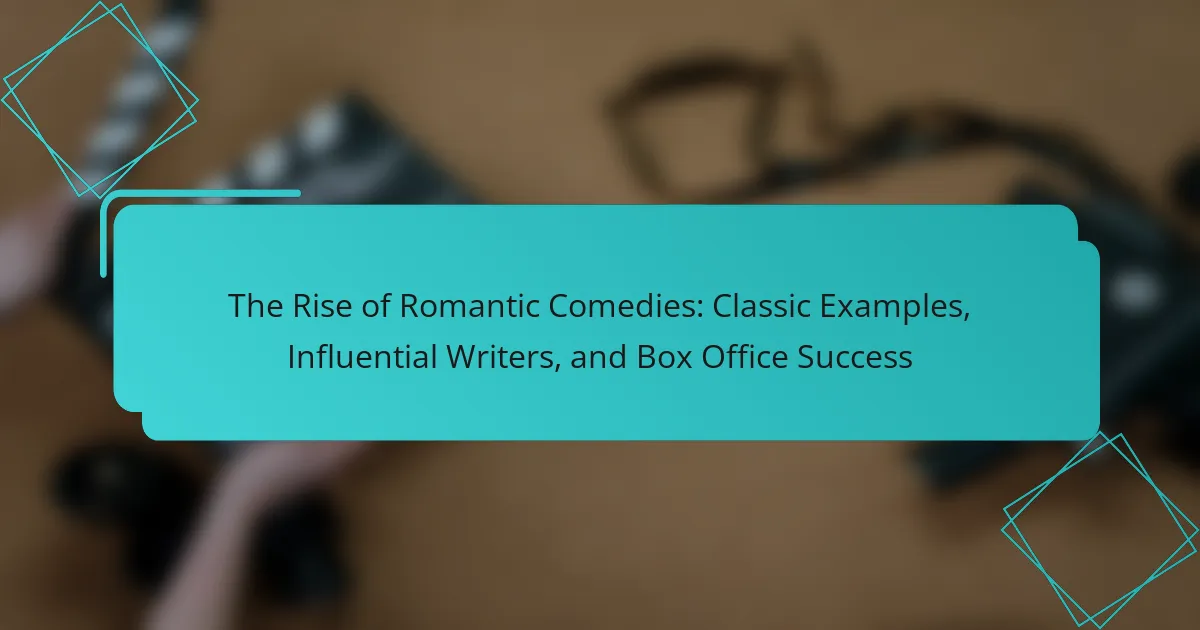Romantic comedies are a film genre that merges romance and humor, focusing on the romantic relationships between characters while incorporating comedic elements. This article examines the rise of romantic comedies, highlighting classic examples such as “When Harry Met Sally,” “Pretty Woman,” and “Notting Hill,” which showcase strong character development and engaging storylines. Influential writers like Nora Ephron, Richard Curtis, and Billy Wilder have significantly shaped the genre, establishing templates for storytelling. The article also discusses the box office success of romantic comedies, noting their appeal to a wide demographic and the impact of streaming services on accessibility and popularity.
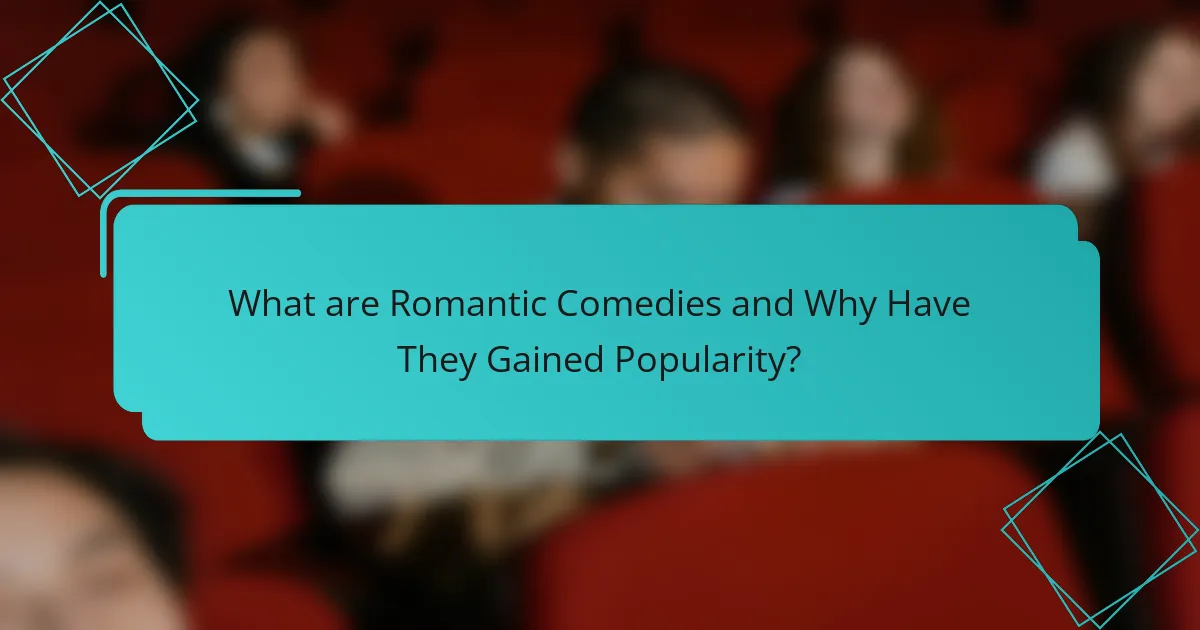
What are Romantic Comedies and Why Have They Gained Popularity?
Romantic comedies are a film genre that combines romance and humor. They typically focus on the romantic relationships between characters while incorporating comedic elements. This genre has gained popularity due to its relatable themes and feel-good narratives. Audiences enjoy the blend of love and laughter, which provides an escape from reality. The rise of streaming services has also increased accessibility to romantic comedies. Data shows that films like “Crazy Rich Asians” and “Notting Hill” have performed well at the box office. Their success often stems from strong character development and engaging storylines. Additionally, the genre appeals to a wide demographic, making it a staple in modern cinema.
How did Romantic Comedies evolve over the decades?
Romantic comedies evolved significantly from the 1930s to the present. In the 1930s and 1940s, films like “It Happened One Night” featured witty dialogue and strong chemistry. The 1950s introduced more traditional roles, as seen in “Roman Holiday.” The 1960s and 1970s experimented with themes of love and social change, exemplified by “The Graduate.” The 1980s brought a resurgence with films like “When Harry Met Sally,” blending humor and romance. The 1990s saw the rise of the modern rom-com, with titles like “Pretty Woman” and “Notting Hill” achieving box office success. In the 2000s, the genre diversified, incorporating elements from other genres, as seen in “50 First Dates.” Today, romantic comedies continue to evolve, reflecting contemporary social issues and diverse relationships, as demonstrated in films like “Crazy Rich Asians.”
What key historical events influenced the rise of Romantic Comedies?
The rise of Romantic Comedies was influenced by several key historical events. The end of World War II marked a significant shift in societal values. This period saw a desire for lighthearted entertainment, reflecting the public’s need for escapism. The 1960s [censured] revolution challenged traditional romantic norms. It encouraged more open expressions of love and relationships in film. The advent of television also played a crucial role. It popularized the genre, bringing romantic stories into living rooms across America. Additionally, the feminist movement in the 1970s reshaped gender roles. This led to more complex female characters in Romantic Comedies. These events collectively contributed to the genre’s evolution and popularity.
How did societal changes shape the themes in Romantic Comedies?
Societal changes significantly shaped the themes in Romantic Comedies. The evolution of gender roles influenced the portrayal of relationships. In the 1950s, traditional gender norms dominated, leading to male-centric narratives. As feminism gained traction in the 1960s and 1970s, female characters became more empowered. This shift allowed for stories that explored women’s independence and desires.
Cultural movements, such as the [censured] revolution, introduced themes of love and sexuality. This resulted in more open discussions about relationships in the 1980s and 1990s. Social issues, like class differences and racial diversity, also began to appear in plots. For instance, films like “Pretty Woman” tackled class disparities, while others embraced multicultural relationships.
The rise of technology and social media further transformed narratives. Modern Romantic Comedies often reflect contemporary dating practices, like online dating. These societal changes have led to a broader range of themes, making Romantic Comedies more relatable to diverse audiences.
What are the defining characteristics of Romantic Comedies?
Romantic comedies are characterized by their blend of romance and humor. They typically feature a central love story that unfolds through comedic situations. The protagonists often face obstacles that create tension and misunderstandings. These films emphasize light-hearted themes, making them feel uplifting. A common structure includes a meet-cute, where the main characters first encounter each other in an amusing way. Romantic comedies often conclude with a happy ending, reinforcing the idea of love conquering all. They also showcase relatable characters and situations, appealing to a broad audience. Examples like “When Harry Met Sally” and “Notting Hill” exemplify these traits effectively.
What common tropes are found in Romantic Comedies?
Common tropes in romantic comedies include the “meet-cute,” where the main characters have an adorable first encounter. Another frequent trope is the “love triangle,” which introduces tension between competing romantic interests. The “opposites attract” theme showcases characters from different backgrounds who ultimately find love. The “misunderstanding” trope often leads to conflict, driving the plot forward. Additionally, “the grand gesture” involves one character making a significant effort to win back their love. The “happy ending” is a hallmark, ensuring that couples reconcile and find happiness together. These tropes create engaging narratives and relatable scenarios for audiences.
How do character archetypes contribute to the genre?
Character archetypes significantly shape the romantic comedy genre. They provide recognizable patterns that audiences connect with emotionally. Common archetypes include the hopeless romantic, the commitment-phobe, and the quirky sidekick. These roles establish expectations for character behavior and development. They drive the plot through predictable dynamics, such as opposites attracting or love triangles. This familiarity enhances viewer engagement and satisfaction. Additionally, archetypes allow for comedic situations rooted in character traits. For instance, the commitment-phobe’s reluctance often leads to humorous misunderstandings. Overall, character archetypes create a framework that defines the romantic comedy experience.
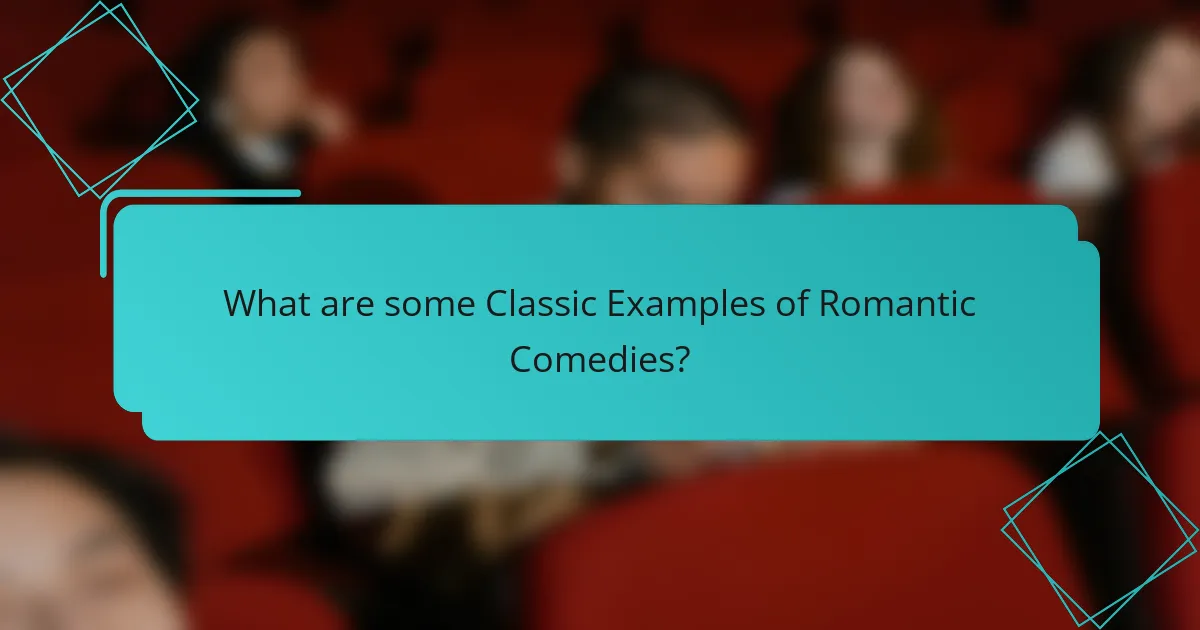
What are some Classic Examples of Romantic Comedies?
Classic examples of romantic comedies include “When Harry Met Sally,” “Pretty Woman,” and “Notting Hill.” “When Harry Met Sally,” released in 1989, explores friendship and love through witty dialogue. “Pretty Woman,” from 1990, features a love story between a businessman and a [censured] worker. “Notting Hill,” released in 1999, tells the tale of a bookstore owner falling for a famous actress. These films are celebrated for their humor and relatable characters. They have significantly influenced the genre and remain popular today.
Which films are considered iconic in the Romantic Comedy genre?
Iconic films in the Romantic Comedy genre include “When Harry Met Sally,” “Pretty Woman,” and “Notting Hill.” “When Harry Met Sally” is renowned for its witty dialogue and exploration of friendship and love. “Pretty Woman” features a classic Cinderella story and strong performances by Julia Roberts and Richard Gere. “Notting Hill” is celebrated for its charming premise of a bookstore owner falling for a famous actress. These films have significantly influenced the genre and remain popular among audiences. Their cultural impact is evident in their continued references in media and their box office success.
What themes are prevalent in these classic films?
Common themes in classic romantic comedies include love, misunderstandings, and personal growth. These films often explore the complexities of relationships. They highlight the journey of characters as they navigate love and conflict. Many classic romantic comedies focus on the idea of opposites attracting. They also depict the importance of friendship and support in romantic pursuits. Themes of fate and serendipity frequently appear, suggesting that love is often a matter of chance. Additionally, societal expectations and norms are critiqued through humor and satire. These themes resonate with audiences, contributing to the genre’s enduring popularity.
How did these films influence subsequent Romantic Comedies?
These films shaped subsequent romantic comedies by establishing key tropes and narrative structures. They popularized the “will-they-won’t-they” dynamic between leads. This tension became a hallmark of the genre, influencing later films. Their blend of humor and romance set a template for storytelling. Iconic scenes and character archetypes, such as the quirky best friend, became standard. These elements are evident in films like “When Harry Met Sally” and “10 Things I Hate About You.” The success of these films demonstrated the commercial viability of romantic comedies. Their influence persists in modern adaptations and original works within the genre.
What are the notable performances in these classic films?
Notable performances in classic romantic comedies include Audrey Hepburn in “Breakfast at Tiffany’s.” Hepburn’s portrayal of Holly Golightly is iconic and celebrated. Another significant performance is Cary Grant in “The Philadelphia Story.” Grant’s charm and comedic timing define the film. Additionally, Meg Ryan in “When Harry Met Sally” delivered a memorable performance. Ryan’s role helped shape the genre in the late 20th century. These performances are often referenced in discussions about the evolution of romantic comedies. Their impact on both audiences and the genre is profound and lasting.
Which actors became synonymous with the Romantic Comedy genre?
Actors who became synonymous with the Romantic Comedy genre include Meg Ryan, Hugh Grant, and Julia Roberts. Meg Ryan defined the genre in the 1990s with films like “When Harry Met Sally” and “Sleepless in Seattle.” Hugh Grant became a leading man in romantic comedies with “Notting Hill” and “Four Weddings and a Funeral.” Julia Roberts starred in iconic films such as “Pretty Woman” and “My Best Friend’s Wedding,” solidifying her status in the genre. These actors consistently delivered performances that resonated with audiences, making them central figures in Romantic Comedies. Their films often achieved significant box office success, further enhancing their association with the genre.
How did their performances impact the success of these films?
Performances significantly impacted the success of romantic comedies. Strong performances often led to increased audience engagement. For instance, the chemistry between lead actors can drive box office sales. In films like “When Harry Met Sally,” the performances contributed to its iconic status. Box office success is often linked to the charisma of the actors. Positive reviews frequently highlight standout performances, influencing viewer decisions. Consequently, memorable performances can create lasting cultural impressions. This interplay between performance and success is evident across various romantic comedies.
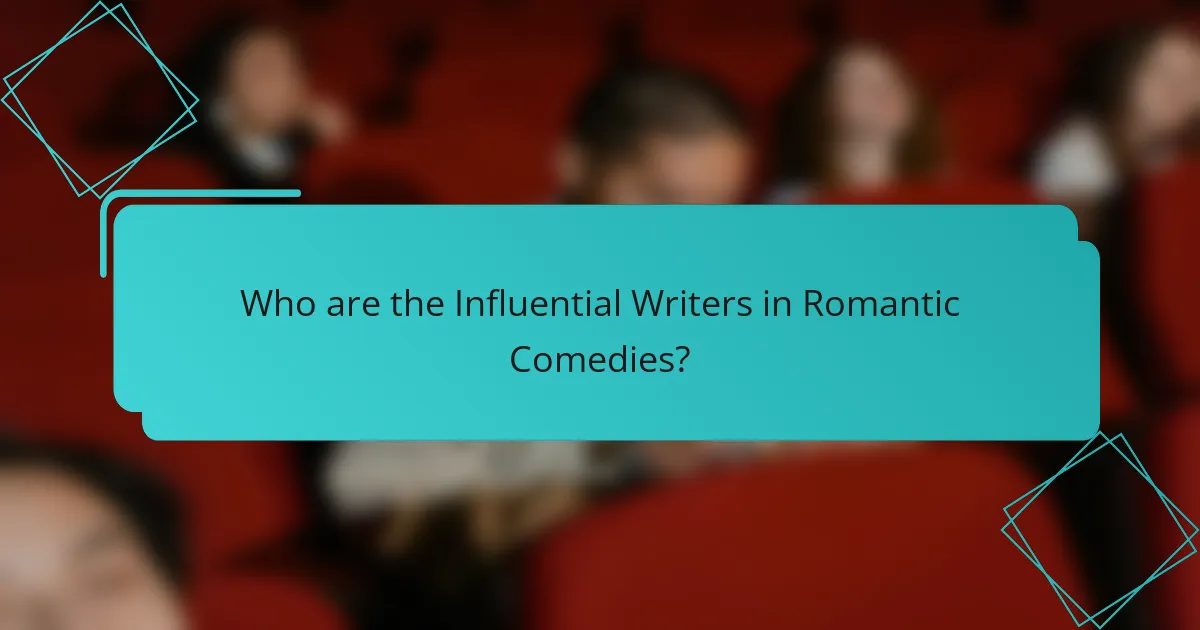
Who are the Influential Writers in Romantic Comedies?
Nora Ephron, Richard Curtis, and Billy Wilder are influential writers in romantic comedies. Nora Ephron is known for films like “When Harry Met Sally” and “Sleepless in Seattle.” Richard Curtis wrote classics such as “Notting Hill” and “Four Weddings and a Funeral.” Billy Wilder contributed significantly with “The Apartment,” blending romance and comedy masterfully. Their works have shaped the genre, establishing templates for storytelling and character development. Each writer’s unique voice has influenced countless films, making them key figures in romantic comedy history.
Which screenwriters have shaped the Romantic Comedy landscape?
Nora Ephron, Richard Curtis, and Billy Wilder are key screenwriters who shaped the Romantic Comedy landscape. Nora Ephron is known for classics like “When Harry Met Sally” and “Sleepless in Seattle.” Richard Curtis wrote iconic films such as “Notting Hill” and “Four Weddings and a Funeral.” Billy Wilder contributed significantly with “The Apartment,” blending romance and comedy effectively. Their work has influenced the genre’s evolution and popularity, establishing enduring tropes and themes. Each writer’s unique voice and storytelling style have left a lasting impact on Romantic Comedies.
What unique styles do these writers bring to the genre?
Influential writers in romantic comedies bring distinctive styles that shape the genre. For example, Nora Ephron’s witty dialogue and relatable characters create a sense of authenticity. Her films often explore the complexities of relationships with humor and heart. Richard Curtis is known for his charming narratives that blend romance with comedic elements. His works often feature ensemble casts and intersecting storylines. Additionally, Woody Allen’s neurotic characters and philosophical undertones add depth to the genre. His unique blend of humor and introspection resonates with audiences. These writers each contribute a unique voice that enriches the romantic comedy landscape.
How have their contributions changed the narrative structure of Romantic Comedies?
Their contributions have introduced new narrative techniques that reshaped Romantic Comedies. Influential writers have incorporated non-linear storytelling and multi-dimensional characters. This has allowed for more complex emotional arcs and relatable scenarios. For example, films like “When Harry Met Sally” use parallel narratives to explore relationships over time. Additionally, the blending of genres has created fresh dynamics. Elements of drama and comedy are often intertwined, enhancing viewer engagement. These changes have led to a more diverse representation of love and relationships. As a result, audiences now experience a richer narrative experience in Romantic Comedies.
What role do directors play in the success of Romantic Comedies?
Directors play a crucial role in the success of romantic comedies. They shape the film’s vision and tone. Their decisions influence casting, pacing, and overall storytelling. A director’s style can enhance comedic timing and emotional depth. For instance, directors like Nora Ephron have been pivotal in defining the genre. Ephron’s films, such as “When Harry Met Sally,” showcase her ability to blend humor with romance effectively. The director’s guidance ensures the chemistry between actors feels authentic. Moreover, their creative choices impact audience engagement and box office performance. A well-directed romantic comedy can resonate with viewers, leading to lasting popularity.
Which directors are known for their work in this genre?
Directors known for their work in romantic comedies include Nora Ephron, Rob Reiner, and Gary Marshall. Nora Ephron directed iconic films like “When Harry Met Sally” and “Sleepless in Seattle.” Rob Reiner is recognized for “The Princess Bride” and “When Harry Met Sally,” showcasing his influence in the genre. Gary Marshall directed “Pretty Woman” and “Runaway Bride,” contributing significantly to romantic comedy’s popularity. Each of these directors has left a lasting mark on the genre through their memorable films and storytelling techniques.
How does a director’s vision influence the overall feel of a Romantic Comedy?
A director’s vision significantly shapes the overall feel of a Romantic Comedy. This vision dictates the tone, pacing, and style of storytelling. For instance, a director may choose a light-hearted, whimsical approach to create a playful atmosphere. This can be seen in films like “10 Things I Hate About You,” where the director’s choices enhance the comedic elements. Alternatively, a more grounded vision can lead to a blend of humor and emotional depth, as seen in “When Harry Met Sally.” The director’s interpretation of characters also influences audience connection. Strong character development leads to relatable and engaging narratives. Ultimately, a cohesive vision ensures that the film resonates with its intended audience, impacting its success in the genre.
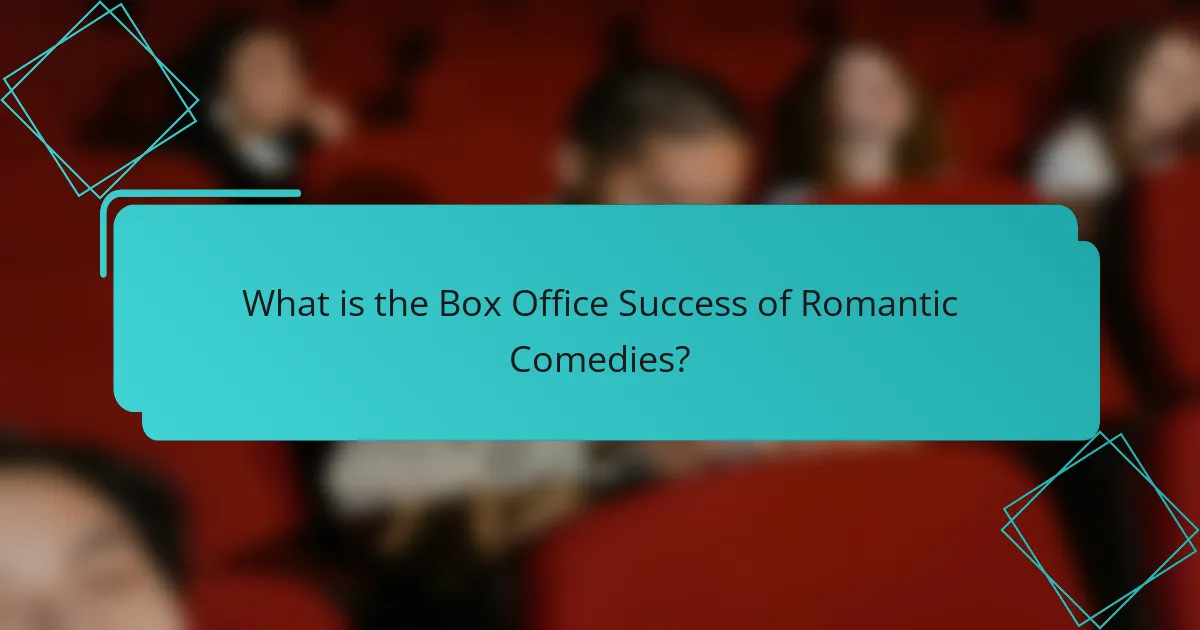
What is the Box Office Success of Romantic Comedies?
Romantic comedies have historically performed well at the box office. Notable examples include “Pretty Woman,” which grossed over $463 million worldwide. “The Proposal” also achieved significant success, earning approximately $317 million globally. In recent years, films like “Crazy Rich Asians” grossed over $238 million, demonstrating continued popularity. The genre often appeals to a broad audience, contributing to its financial success. Factors such as relatable storylines and star power enhance box office performance. Overall, romantic comedies remain a profitable genre in the film industry.
How have Romantic Comedies performed at the box office over the years?
Romantic comedies have experienced fluctuating box office performance over the years. In the 1990s, films like “Pretty Woman” and “Notting Hill” grossed over $400 million worldwide. The genre peaked in the early 2000s with hits such as “Love Actually,” which earned approximately $246 million globally. However, in the 2010s, box office numbers declined significantly. For instance, “How to Be Single” grossed around $112 million, indicating a drop in audience interest. Recent years have shown a resurgence, with films like “Crazy Rich Asians” earning over $238 million in 2018. This indicates that while romantic comedies have faced challenges, they continue to attract audiences when executed well.
What factors contribute to the financial success of these films?
Successful romantic comedies often achieve financial success through a combination of strong star power, relatable storylines, and effective marketing strategies. Star power attracts audiences, as popular actors can drive ticket sales. Relatable storylines resonate with viewers, making them more likely to engage with the film. Effective marketing strategies, including social media campaigns and targeted advertising, increase visibility and anticipation. Additionally, positive word-of-mouth and critical reviews can enhance a film’s reputation, leading to higher box office returns. Historical data shows that films with these factors often outperform others in the same genre. For example, “Crazy Rich Asians” grossed over $238 million worldwide, benefiting from a diverse cast and a compelling narrative.
Which recent Romantic Comedies have achieved significant box office success?
Recent romantic comedies that have achieved significant box office success include “Crazy Rich Asians,” “The Proposal,” and “Ticket to Paradise.” “Crazy Rich Asians” grossed over $238 million worldwide, becoming a cultural phenomenon. “The Proposal” earned approximately $317 million globally, showcasing its enduring popularity. “Ticket to Paradise,” released in 2022, has garnered over $100 million at the box office, highlighting the genre’s continued appeal. These films demonstrate the commercial viability of romantic comedies in recent years.
What marketing strategies are effective for promoting Romantic Comedies?
Effective marketing strategies for promoting romantic comedies include targeted social media campaigns, influencer partnerships, and engaging trailers. Social media platforms like Instagram and TikTok are ideal for reaching younger audiences. Influencers can create buzz by sharing personal connections to the film’s themes. Engaging trailers should highlight humor and romance to attract viewers. Additionally, hosting special screenings can generate word-of-mouth promotion. Collaborations with brands that resonate with the film’s target demographic can enhance visibility. Research shows that films marketed through social media campaigns experience a 20% increase in audience engagement.
How do trailers and promotional materials appeal to audiences?
Trailers and promotional materials appeal to audiences by generating excitement and anticipation. They highlight key scenes, showcase star performances, and use engaging visuals. This creates a strong emotional connection with potential viewers. Soundtracks in trailers often evoke feelings that resonate with the film’s themes. Additionally, promotional materials utilize social media to reach broader audiences. Statistics show that 70% of moviegoers decide to watch a film based on its trailer. Effective marketing strategies also include memorable taglines and posters that capture attention. Overall, these elements work together to draw audiences into the cinematic experience.
What role does social media play in the marketing of Romantic Comedies?
Social media significantly enhances the marketing of romantic comedies. It allows filmmakers to engage directly with audiences. Platforms like Instagram and Twitter create buzz through trailers and behind-the-scenes content. This engagement fosters community and anticipation around the film. Social media campaigns can target specific demographics effectively. For instance, a study by the Pew Research Center shows that 69% of adults use social media, making it a vital tool for reaching potential viewers. Additionally, viral marketing strategies can amplify word-of-mouth promotion. User-generated content and fan interactions further increase visibility and interest. Overall, social media serves as a powerful catalyst in the marketing strategy for romantic comedies.
What are the current trends in Romantic Comedies?
Current trends in romantic comedies include a focus on diverse representation and inclusive storytelling. Films increasingly feature a variety of cultural backgrounds and relationship dynamics. Streaming platforms are driving the trend by producing original romantic comedies that appeal to younger audiences. Additionally, there is a rise in blending genres, incorporating elements of drama and fantasy. Social media influences plotlines and character development, reflecting modern dating experiences. The success of films like “Crazy Rich Asians” demonstrates the demand for fresh narratives. Overall, these trends highlight evolving societal norms and viewer preferences in romantic comedies.
How are modern Romantic Comedies evolving to meet audience expectations?
Modern romantic comedies are evolving by incorporating diverse narratives and complex characters. They now reflect a broader range of relationships and identities. This shift aligns with changing societal norms and audience expectations. Recent films feature non-traditional couples and explore themes like mental health and personal growth. For instance, “Crazy Rich Asians” broke box office records while showcasing Asian representation. Additionally, streaming platforms have increased access to varied romantic comedies, catering to niche audiences. This evolution demonstrates a commitment to authenticity and relatability in storytelling. As a result, modern romantic comedies resonate more with contemporary viewers.
What themes are emerging in contemporary Romantic Comedies?
Emerging themes in contemporary romantic comedies include diversity, self-discovery, and modern relationships. These films increasingly feature diverse casts that reflect societal changes. Self-discovery is often central, with characters exploring personal growth. Modern relationships are portrayed with realism, addressing issues like mental health and commitment. Additionally, technology’s impact on dating is frequently highlighted. Studies show that these themes resonate with audiences, making the genre more relatable. For example, films like “Crazy Rich Asians” and “The Lovebirds” exemplify these emerging trends.
What tips can aspiring filmmakers learn from successful Romantic Comedies?
Aspiring filmmakers can learn several valuable tips from successful romantic comedies. First, they should focus on strong character development. Engaging characters drive the narrative and connect with audiences. Second, they must master the art of comedic timing. Successful romantic comedies often balance humor with emotional depth. Third, filmmakers should incorporate relatable conflicts. These conflicts keep the story engaging and resonate with viewers. Fourth, they should consider the importance of chemistry between leads. On-screen chemistry enhances the romantic aspect of the film. Fifth, filmmakers need to create a satisfying resolution. A well-crafted ending leaves audiences feeling fulfilled. Lastly, they should study successful examples like “When Harry Met Sally” and “Notting Hill.” These films showcase effective storytelling techniques and character dynamics.
The main entity of the article is romantic comedies, a film genre that combines romance and humor, focusing on the relationships between characters. The article explores the evolution of romantic comedies over the decades, highlighting key historical events and societal changes that influenced their themes and narratives. It examines defining characteristics, common tropes, and influential writers and directors who shaped the genre. Additionally, the article discusses the box office success of notable films and current trends in romantic comedies, emphasizing the importance of diverse representation and modern storytelling techniques.
